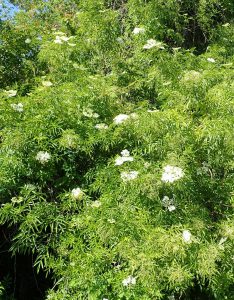
American Elderberry is an interesting-looking Florida native plant that’s putting on a show now along roadsideswith its blooms and berries. In recent years, Elderberry products have become some of the most in-demand health supplements on the market, with $265.8 million in U.S. Elderberry product sales in 2020, up 169% from the previous year. Unfortunately, adulteration of commercially available Elderberry products (with less beneficial plant products) is increasing, making it more appealing for some to make their own Elderberry products.
I love educating people about “Edible Landscaping”, that is, using attractive plants in the home landscape that can also be used for food, beverages, or health. I’m often asked why I don’t discuss elderberry more as an edible landscape plant. Well, it’s complicated. I’ll tell you about pros and cons of this plant and you can decide if elderberry would be a good plant for your landscape.
The Good
People throughout the world have used Elderberry species in medicine for thousands of years. The fruit has antibacterial, antiviral, and anti-inflammatory properties and more vitamin A and C, iron, and antioxidants than blueberries or cranberries. American Elderberry is easy-to-grow and can be grown in wet areas where many other plants won’t do well. This 10 ft.+ shrub has pretty foliage, lovely white flowers and produces clusters of edible black fruits.
The tiny fruits are processed for many uses including syrup, juice, wine, jam, and pie. The fruit also has use as a colorant for food and fiber. Elderflowers can be used to make tea, liqueur, jelly, or vinegar. The scent and flavor of American Elderberry flowers is pleasant, although not considered as appealing as other species of Elderberry for some uses. The flowers are pollinator attractors and the fruit is a favorite of songbirds.
The Bad
Like many plants we eat, (i.e. almonds and yuca) Elderberry plants contain toxins including a cyanide-producing compound. I don’t recommend that you eat Elderberry stems, leaves or fruit raw. Fortunately, cooking destroys the toxins. Be cautious about planting it if you have livestock or a dog that likes to chew everything, as various plant parts can be toxic for some mammals.
Since Elderberry grows wild throughout Florida, many people simply forage wild berries and flowers, which means that they need good plant identification skills to accurately recognize Elderberry. Be aware: Elderberry looks a lot like Water Hemlock, which is one of the most deadly plants in Florida. They also grow in some of the same wet habitats. The leaves and flowers of both plants look similar, but Water Hemlock doesn’t produce purple berries. Purchase an elderberry plant from a nursery or pick flowers with an experienced forager.
The Ugly
Elderberry is best suited for large, naturalistic landscapes that don’t require a formal appearance. Although it can be an attractive plant, it does have a leggy form that doesn’t do well with hedging or shaping. American Elderberry spreads from the roots; it’s difficult to keep it confined in a small area of the landscape. Common varieties of tall Elderberry are not ideal for container growing. Elderberry is semi-deciduous here (loses leaves) and is susceptible to several pests and diseases that may affect it’s appearance periodically.
Growing and foraging
Nurseries that specialize in native or edible plants often sell Elderberry. In Osceola County, FL, check with South Eden Edible Nursery, Nick’s Edibles, and Bobcat Acres. You can readily find native American Elderberry (Sambucus nigra subspecies Canadensis) through many sources, and additional cultivated species and varieties are available that have improved fruit quality. Be sure to use varieties that are native or adapted to our hot, humid region. New Elderberry varieties have also been developed for their ornamental value, featuring different colors and shapes of leaves and dwarf types. Plants grown for ornamental use may have been treated with pesticides that are not approved for edible plants.
Elderberry plants grow best in sunny locations and moist soils with plenty of organic matter. You can grow them from stem cuttings, rooted offshoots from a parent plant, or containerized plants.
Birds will start picking the fruits off when they are still green; use bird netting over your plants if you plan to harvest the fruit. If you are foraging Elderberry fruit, avoid plant sources in ditches or ponds that are likely to have polluted stormwater runoff.
Using Elderberry
Elderberry typically flowers in spring and fruits in summer, but can also bloom sporadically throughout the year. Harvest elderflowers by cutting off entire, dry, blooming flower clusters. They can be used fresh, or dried in a dark, dry place, then frozen for use later. Once dried, flowers should be separated from stems. Flowers will turn into fruit later, so if you plan to harvest fruit from the same plants later, don’t harvest all of the flowers.
Fruit should be harvested when completely ripe and purple-black. It can be processed immediately or washed and frozen for future use. The beneficial anthocyanins are destroyed with excessive heat, so avoid extensive cooking.
Whether you decide to give Elderberry a place in your landscape or not, I hope you’ll now recognize this valuable food plant for more than just a weed growing by the road. Read more about elderberry in this factsheet.
For more information on landscaping, gardening, or farming, contact the UF IFAS Extension in Osceola County: 321-697-3000.
 1
1
